Filters for Sigma 1424 Dg Dn Art for Sony Best Buy
Summary
 The Sigma 14-24mm f2.viii DG DN Art is an ultra-wide-angle lens designed for full-frame mirrorless cameras and bachelor in the Sony Due east and Leica L mounts. It demonstrates the virtues of optical designs which are optimized for the shorter flange distances of mirrorless cameras: it is optically meliorate in almost every attribute than its DSLR sibling and loses more 300g in weight. Its optical functioning is almost flawless with a slight loss of contrast at 24mm, f2.8 in the center from haloing/blooming. Simply that doesn't forestall the lens coming Highly Recommended! Allow's hope that Sigma soon is able to offer their new lens with Nikon Z-mount and Catechism RF-mount as well.
The Sigma 14-24mm f2.viii DG DN Art is an ultra-wide-angle lens designed for full-frame mirrorless cameras and bachelor in the Sony Due east and Leica L mounts. It demonstrates the virtues of optical designs which are optimized for the shorter flange distances of mirrorless cameras: it is optically meliorate in almost every attribute than its DSLR sibling and loses more 300g in weight. Its optical functioning is almost flawless with a slight loss of contrast at 24mm, f2.8 in the center from haloing/blooming. Simply that doesn't forestall the lens coming Highly Recommended! Allow's hope that Sigma soon is able to offer their new lens with Nikon Z-mount and Catechism RF-mount as well.
Purchase it at present!
Bank check prices on the Sigma fourteen-24mm f2.8 DG DN Art at Amazon, B&H, Adorama, Wex, or Calumet.de. Alternatively get yourself a re-create of my In Photographic camera book or treat me to a coffee! Thanks!
Sigma xiv-24mm f2.viii DG DN Art review -
- Written by
Intro
The Sigma 14-24mm f2.8 DG DN Art is an ultra-broad bending zoom lens designed for full-frame mirrorless cameras and available in the Sony E and Leica L mounts, the latter working on Leica, Panasonic and Sigma L-mountain bodies. Similar other 14-24mm lenses, information technology delivers wide to ultra-broad coverage that's ideal for dramatic urban and natural landscapes, while maintaining a bright and constant f2.8 focal ratio across the range.
The Sigma 14-24mm f2.eight DG DN Fine art was announced in July 2019 and is currently listed at 1450 EUR / 1399 USD / 1299 GBP. PS – if you're interested in the other Sigma DG DN Art lenses check out our in-depth reviews: Sigma 35mm f1.two DG DN Fine art review, Sigma 24-70mm f2.viii DG DN Art review, Sigma 85mm f1.4 DG DN Art review, Sigma 105mm f2.8 DG DN Macro Art review.
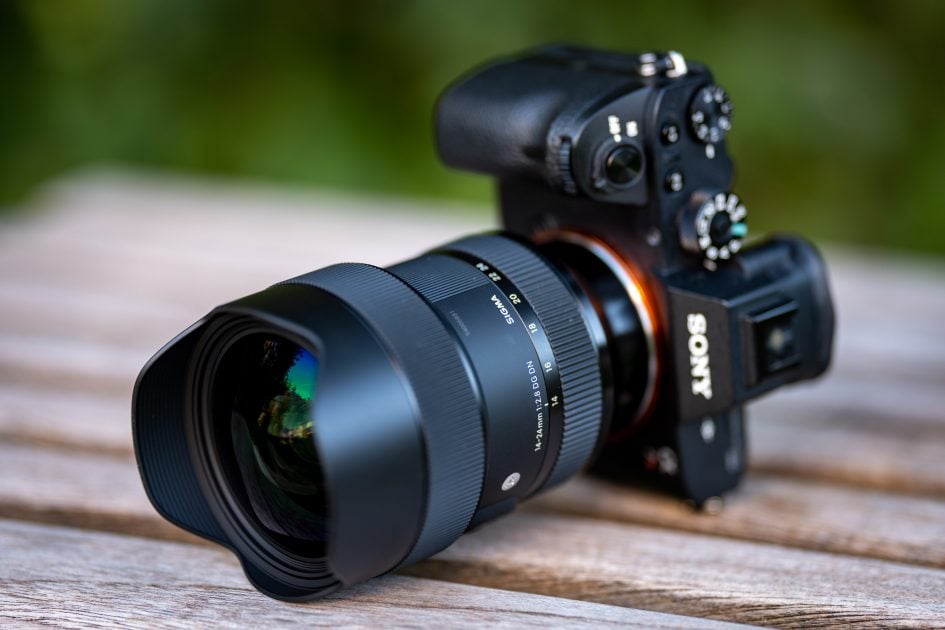
Facts from the catalog
Let's compare the Sigma 14-24mm f2.eight DG DN Art ("Sigma DN" for curt) to the Sony FE 12-24mm f4.0 Chiliad ("Sony f4.0 Chiliad"), Sony FE 12-24mm f2.8 GM ("Sony f2.eight GM"), and Sigma 14-24mm f2.8 DG HSM Fine art ("Sigma HSM") which was designed for DSLRs but still can exist used via Sigma's MC-11 mount-converter on a Sony mirrorless photographic camera. As usual I've rated the features with a [+] (or [++]), when it'southward better than boilerplate or even state of the fine art, a [0] if it's standard or just average, and [-] if there'south a disadvantage.
Size (diameter ten length): All four lenses have a born lens hood and don't change their length when zooming. At 86 ten 132mm (three.iv x 5.2in.) the Sigma DN is longer than the Sony f4.0 One thousand at 87 10 117mm. Merely both the Sony f2.8 GM at 97 x 137mm and the Sigma HSM at 96 x 132mm are bigger lenses, the mountain-converter calculation another 26mm to the length of the Sigma HSM. [0]
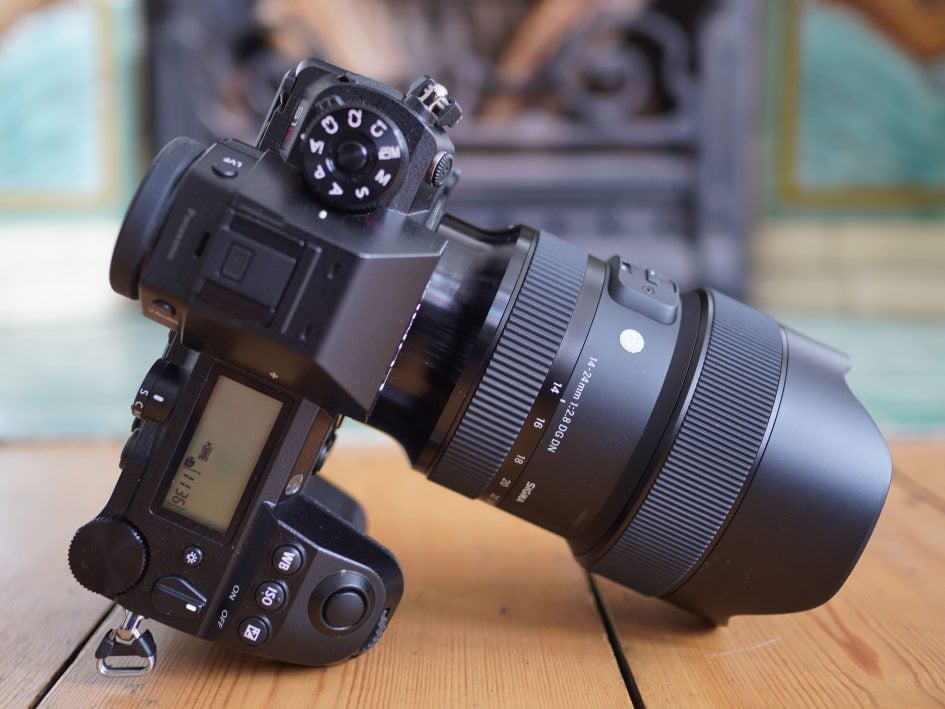
Weight: At 797g (28 oz.) the Sigma DN is 234g heavier than the Sony f4.0 1000 at 563g but still a bit lighter than the Sony f2.eight GM at 847g. The Sigma HSM is much heavier at 1122g plus an estimated 100g for the mountain-converter. [0]
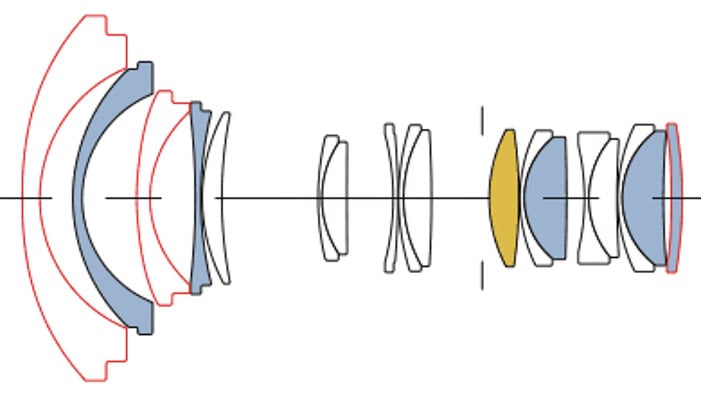
Optics: The Sigma 14-24mm f2.8 DG DN Art has 18 elements in 13 groups including 6 special dispersion elements and 3 aspherical elements. This is similar to the other lenses in this comparing. To reduce reflections causing flare, glare and ghosting the Sigma DN employs Nano-coating. It also has fluorine-coating on the front element to repel water, dust, and dirt and make cleaning easier. [+]
Closest focus distance is 0.23m (0.91ft.) at 24mm focal length with a magnification of 1:5.1 which is similar to the Sigma HSM. This results in a working distance of only 8cm. The Sonys achieve virtually ane:7 at 28cm focus altitude. A magnification of ane:10 is achieved at around 0.35m focus altitude with all four lenses. [+]
Filter-thread: None of the four lenses in this comparison offer filter-thread – their bulbous front elements prevent that. So you need to get some non-standard mounting arrangement and a new ready of filters. Or use gel filters in a rear filter holder on the Sigma DN (see epitome beneath) and the Sony f2.eight GM. Keep in heed though that gels cannot be rotated which precludes the use of polarizers. Sigma supplies a template with the lens to cut out the gels. But yous can as well buy ready-made rear lens filters. [0]
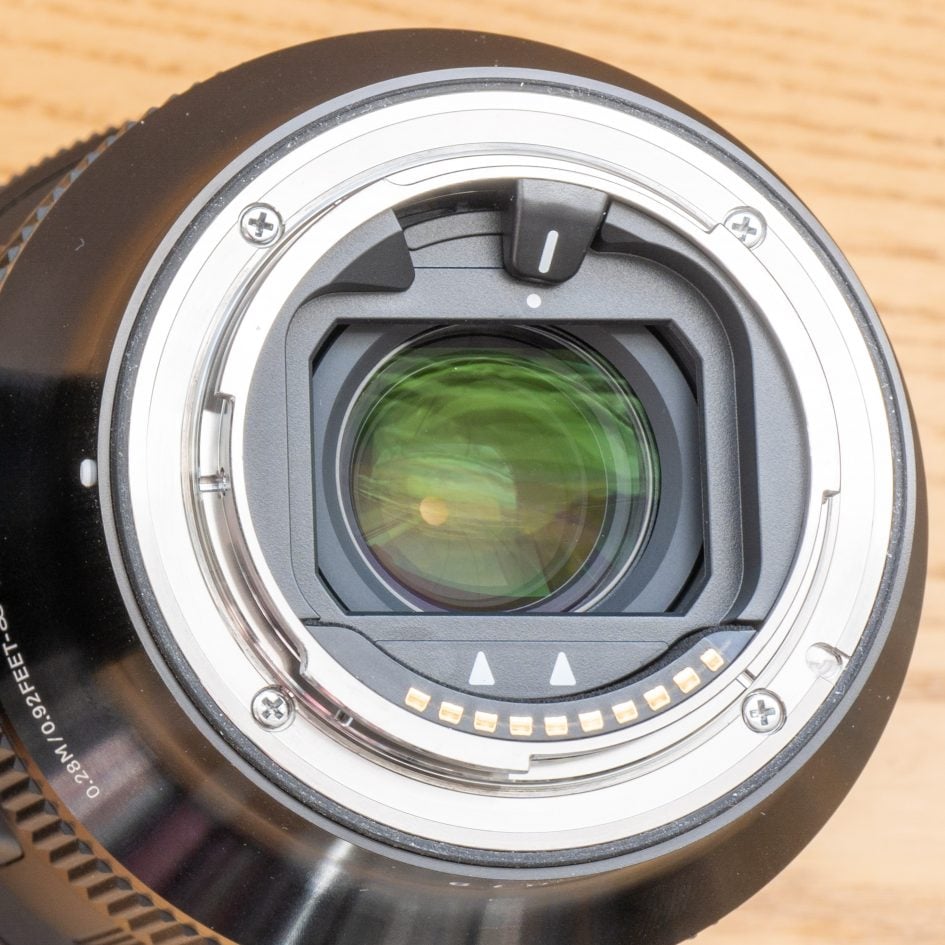
To a higher place: rear filter holder of Sigma 14-24mm f2.viii DG DN Art
Image stabilization: All four lenses in this comparison have no optical image stabilization. But the Sony A7 or Panasonic DC-S1 camera bodies provide built-in sensor-shift stabilization. [0]
Car focus: Aye with built-in AF drive. Manual-focus override is by but turning the defended focus ring at the front end of the lens. Information technology has a variable gearing (like many lenses designed for mirrorless cameras) which allows for very precise transmission focus when turned slowly but cannot be switched to linear gearing. Which makes smooth focus pulling for videographers pretty hard. Same with the Sonys. The three lenses designed for mirrorless cameras also accept an extra push button which can be assigned many different functions e.yard. AF-lock. The Sigma HSM has the usual direct linear coupling that is typical for lenses designed for DSLRs – and shows the focus altitude in a small window. [+]
Lens contour: The lens comes with a lens profile for vignette-, CA- and distortion-compensation which tin be controlled from the camera. That'due south the same as with the Sonys. With the Sigma HSM you lot accept to rely on the profiles supplied e.g. in Adobe's software. [+]
Covers total frame/FF or smaller. Same with the other three lenses. [+]
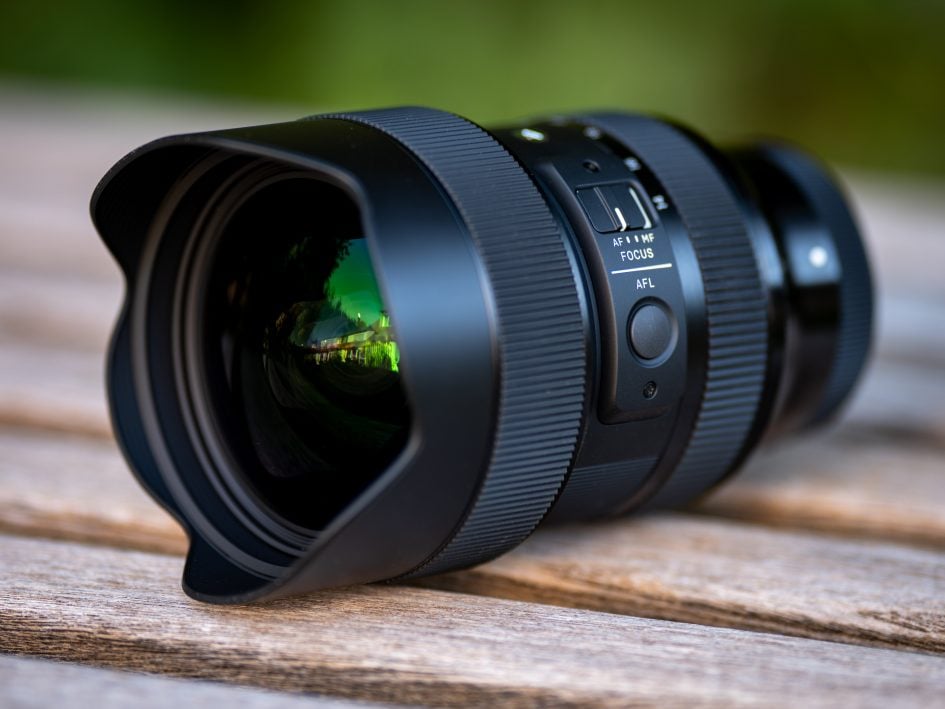
Price: 1450 EUR (incl. xvi% VAT) / 1399 USD / 1299 GBP. The Sony f4.0 G currently goes for 1550 EUR / 1670 USD / 1400 GBP, the Sony f2.8 GM is at 3300 EUR / 3000 USD / 2900 GBP and the Sigma HSM at 1280 EUR / 1199 USD / 1129 GBP. [0]
Discontinuity ring: None of the four lenses in this comparison has an discontinuity ring. [0]
The lens comes with a padded pouch simply no straps. [+]
Sigma's service can change the mountain of the lens betwixt Sony's East-mount and L-mount (at a price). This is a unique feature that no other manufacturer offers. [++]
Sealing: yeah, a safe grommet at the lens-mount plus further special weather condition-sealing throughout the construction, just similar the other three lenses. [+]
The score in the "features-department" is 0[-]/vi[0]/9[+] The Sigma xiv-24mm f2.8 DG DN Art offers a squeamish feature prepare and the unique option to become the lens-mount swapped. The biggest complaint compared to some of the rivals here is that it doesn't zoom wider than 14mm, but while 12mm volition capture a wider field, 14mm still delivers enormous coverage. Some other issue, common to most ultra-wide zooms, is needing some non-standard mounting system if you're going to apply front filters.
Three ultra-wide zoom lenses
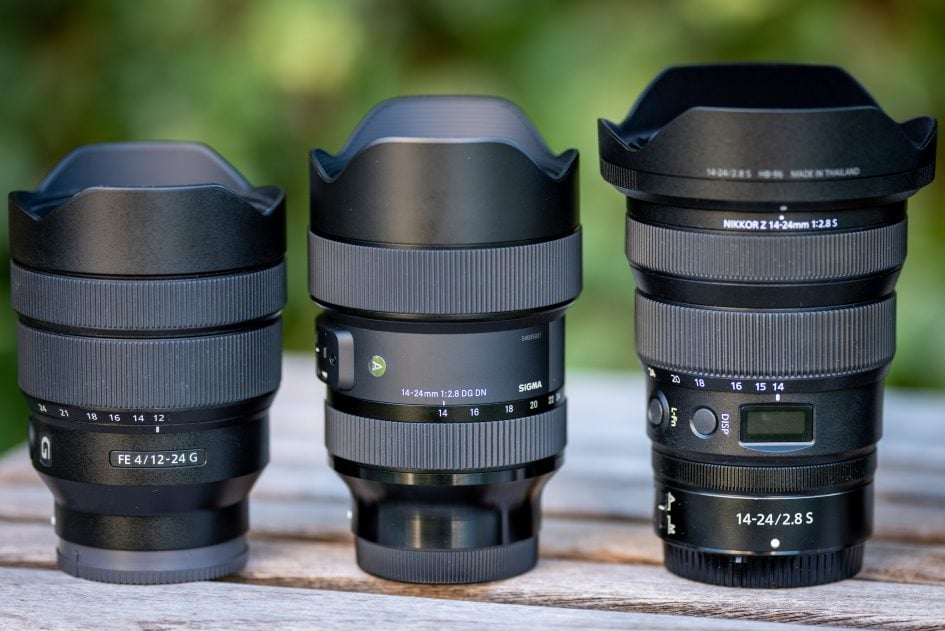
Above from left to right: Sony FE 12-24mm f4.0 Thousand, Sigma 14-24mm f2.8 DG DN Art, Nikon Z 14-24mm f2.8 S
Alternatives
If you want to embrace the range of focal lengths from 14mm to 24mm at that place are actually only two alternatives to the Sigma 14-24mm f2.8 DG DN Art for E-mountain and none for L-mount:
- Sony has the Iron 12-24mm f4.0 G from 2017 and the Fe 12-24mm f2.8 GM. Both lenses kickoff at 12mm focal length giving an viii degrees wider view on the short end than zoom lenses starting at 14mm. The Sony f4.0 G is only slightly more than expensive than the Sigma DN but its focal ratio is one stop slower. And the Sony f2.8 GM has the same bright f2.eight focal ratio simply is more than than twice the toll of the Sigma DN.
Other alternatives cover different focal lengths similar the Panasonic Lumix Due south PRO xvi-35mm f4.0 or the very expensive Leica Super-Vario-Elmar-SL 16-35mm f3.5-4.5 ASPH (both for Fifty-mount). Or the manual focus Laowa ten-18mm f4.5-5.6 which is available for E- and 50-mountain and is currently the but full frame zoom lens starting at 10mm focal length with a recti-linear projection. Or you lot use older DLSR designs via mountain adapter.
Here is the angle of view that the Sigma 14-24mm f2.eight DG DN Art covers with its 1.7x zoom compared to the 2x coverage of the Sony Fe 12-24mm f4.0 G:

Above: Sigma 14-24mm f2.8 DG DN Art coverage on Sony A7R II (FF) trunk at 14mm (left) and 24mm (right)

Above: Sony 12-24mm f4.0 G coverage on Sony A7R Two (FF) body at 12mm (left) and 24mm (right)
Focus and zoom
Focus accuracy and repeatability is critical to consistently produce sharp shots. Repeatability (the accuracy of focus on the same subject after repeated focus-acquisition) of the Sigma at 24mm focal length is skilful (measured 98.ii% in Reikan FoCal) with no outliers over a series of 40 shots. There is a chip of focus variation whether the lens focuses from a closer distance or from infinity and I had some cases of hunting. At 24mm focal length the lens focuses in around 0.7 sec from infinity to 0.35m (1:10 magnification), which is OK merely slower than the Sony Fe 12-24mm f4.0 Thousand which took only 0.v sec.
The zoom ring turns through seventy degrees the other way around than Sony users are used to and has a 14mm wide safe surface with a good grip. It can inappreciably exist operated with one finger every bit it needs more than force than the Sony Fe 12-24mm f4.0 G. The focus ring at the front end is 20mm broad and moves smoothly.
AF-operation of the Sigma is inaudible from the exterior or if yous tape video with the built-in microphone. Same with the Sony Iron 12-24mm f4.0 G.
As you pull focus, you lot'll hardly detect whatever focus breathing: When I adjusted the focus from infinity to 0.35m on the Sigma I measured a one% decrease in magnification at 24mm and 14mm focal length. This is similar to the Sony Fe 12-24mm f4.0 Thousand.
The Sigma zoom lens is parfocal: When I focused the lens at 24mm and zoomed back to 14mm focus stays on the aforementioned spot. Aforementioned with the Sony FE 12-24mm f4.0 G.
Side by side check out my quality results!
Check prices on the Sigma 14-24mm f2.8 DG DN Art at Amazon, B&H, Adorama, Wex, or Calumet.de. Alternatively get yourself a copy of my In Camera volume or treat me to a coffee! Thank you!
Pages: 1 2 3 four
Source: https://www.cameralabs.com/sigma-14-24mm-f2-8-dg-dn-art-review/
0 Response to "Filters for Sigma 1424 Dg Dn Art for Sony Best Buy"
Post a Comment